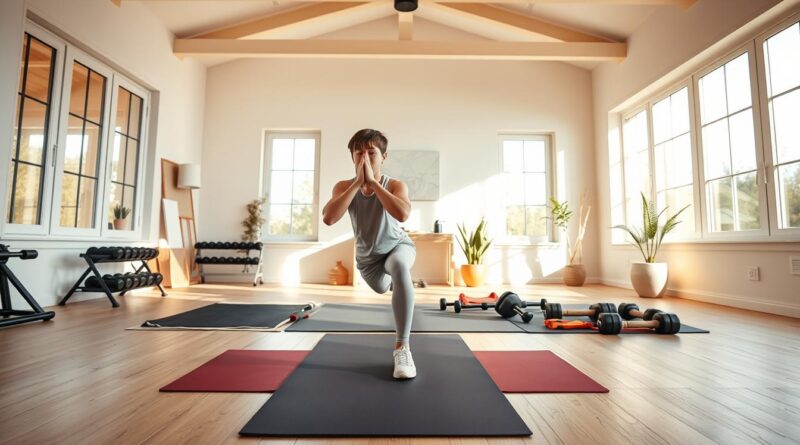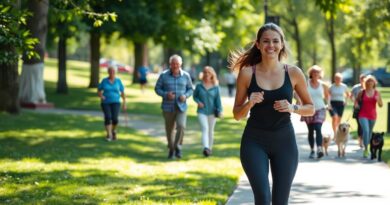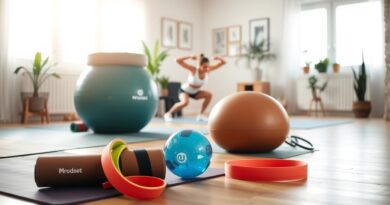Best Home Workout for Beginners: Get Fit at Home
Starting your fitness journey at home is both easy and effective. You can reach your fitness goals without going to the gym. Simple exercises are just as good as complex ones, especially for beginners.
Working out at home lets you make a routine that suits you. You can start with short workouts and grow them as you get more comfortable. This flexibility is a big plus for beginners.
Key Takeaways
- Convenience is a big plus of working out at home.
- Simple exercises can help you reach your fitness goals.
- It’s easy to create a routine that fits your schedule at home.
- You can start with short sessions and grow them over time.
- Home workouts offer flexibility and comfort.
Why Home Workouts Are Perfect for Beginners
Home workouts are great for beginners who want to start their fitness journey at home. They are flexible and easy to access. This makes it easier to start exercising without the stress or cost of gyms.
Benefits of Starting Your Fitness Journey at Home
Starting your beginner workout plan at home lets you exercise at your own pace. You can do it in the comfort of your own space. This reduces stress and helps you stick to a routine.
Home workouts also save time and money. You won’t have to spend money on gym memberships or waste time commuting. Plus, you can start with simple exercises and get more intense as you get better.
Overcoming Common Barriers to Exercise
Many people find it hard to start exercising because of time, fear of judgment, or money. Home workouts solve these problems by offering a private and affordable option. You can work out whenever it’s best for you, without worrying about gym hours or crowds.
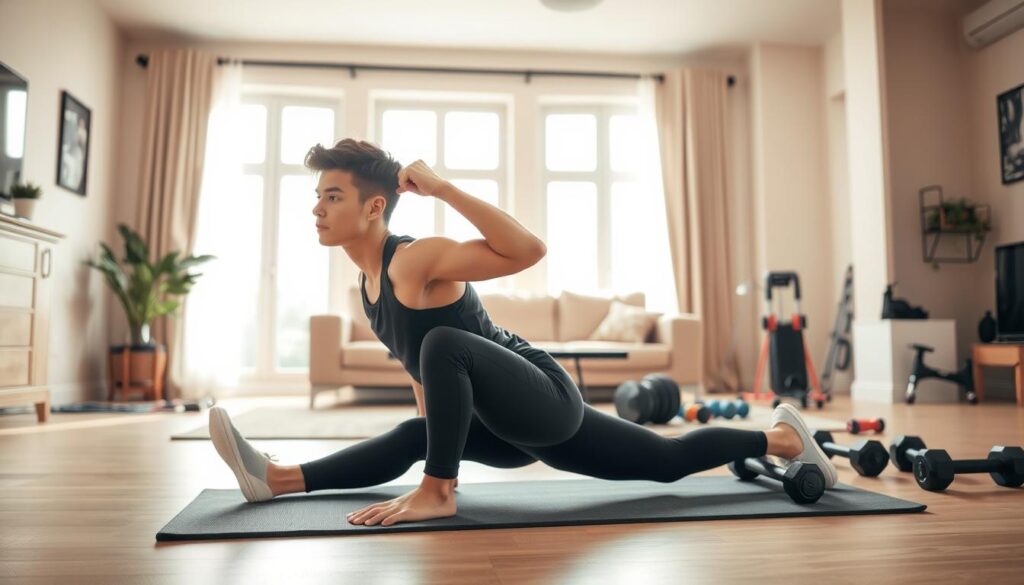
By starting at home, you’re more likely to keep going. It fits into your life, not the other way around. This flexibility is key to staying motivated and reaching your fitness goals.
Essential Equipment for the Best Home Workout for Beginners
Starting a home workout doesn’t need a lot of gear. You can begin your fitness journey with just a little money.
For beginners, it’s key to know that effective home workouts for beginners can be done with little or no equipment. This makes it easy for everyone, no matter their budget or space.
No-Equipment Options for Complete Beginners
Bodyweight exercises are a great start. They use your own weight as resistance and can be done anywhere. Examples include:
- Push-ups
- Squats
- Lunges
- Planks
Basic Equipment Worth Investing In
As you get better, adding some basic equipment to your routine might be helpful. This can include:
- Resistance bands
- Dumbbells
- A yoga mat
These items are cheap and versatile. They let you do many different exercises.
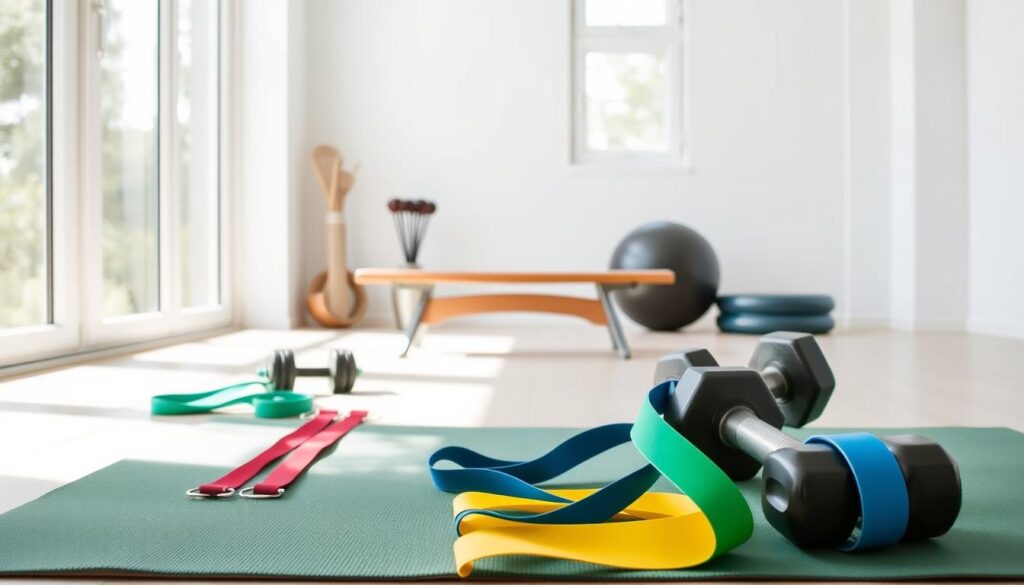
Creating Your Workout Space
Having a dedicated workout area is important, no matter the equipment. Clear a spot in your home that’s free from distractions. Adding a mirror can help with checking your form.
Start with the basics and add equipment as you go. This way, you can create a home workout routine that meets your needs and helps you reach your fitness goals.
Preparing Your Body and Mind for Home Exercise
Before starting beginner-friendly home exercises, it’s key to get your body and mind ready. This prep is crucial for a safe and effective start to your home workout routine.
To get started, consider the following key aspects:
Setting Realistic Expectations
Setting achievable goals is vital. Remember, fitness is a journey, and progress takes time. Begin with manageable targets and gradually increase the intensity and duration of your workouts.
Understanding Your Current Fitness Level
Assess your current fitness level to tailor your workout plan effectively. Consider factors like your cardiovascular health, strength, and flexibility. This self-assessment will help you choose exercises that suit your abilities.
Safety Considerations for Beginners
Safety should always be your top priority. Ensure your workout space is clear of obstacles, and you’re aware of proper exercise techniques to avoid injuries. Listen to your body and rest when needed.
| Aspect | Description | Tips for Beginners |
|---|---|---|
| Realistic Expectations | Setting achievable goals based on your current fitness level. | Start with short workouts and gradually increase duration. |
| Fitness Level Assessment | Understanding your cardiovascular health, strength, and flexibility. | Consider a beginner’s fitness assessment or consult a professional. |
| Safety Precautions | Ensuring a safe workout environment and proper techniques. | Clear your workout space and learn basic exercise forms. |
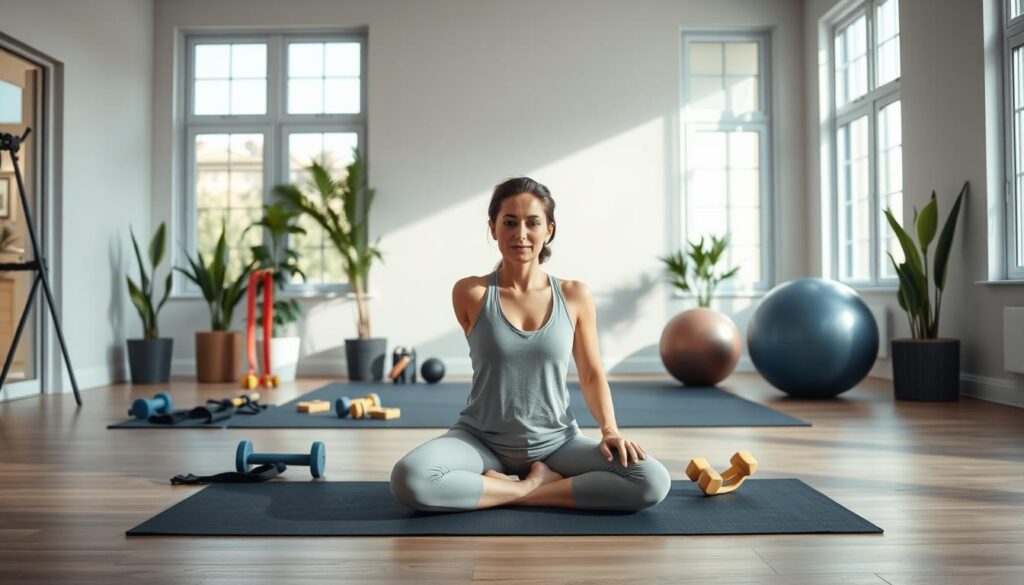
Warm-Up Routines to Prevent Injury
Starting your home workout with a warm-up is key. It helps prevent injuries and gets your muscles ready. A good warm-up boosts blood flow, reduces muscle stiffness, and improves your performance.
5-Minute Dynamic Stretching Sequence
A dynamic stretching sequence is a great warm-up. It moves your joints and keeps your muscles active. Here’s a 5-minute sequence:
- Leg swings (front and back)
- Arm circles (forward and backward)
- Hip circles (clockwise and counterclockwise)
- Knee lifts
- Calf raises
Essential Joint Mobility Exercises
Joint mobility exercises keep you flexible and injury-free. Focus on these:
- Neck stretches (left and right)
- Shoulder rolls
- Wrist rotations
- Ankle circles
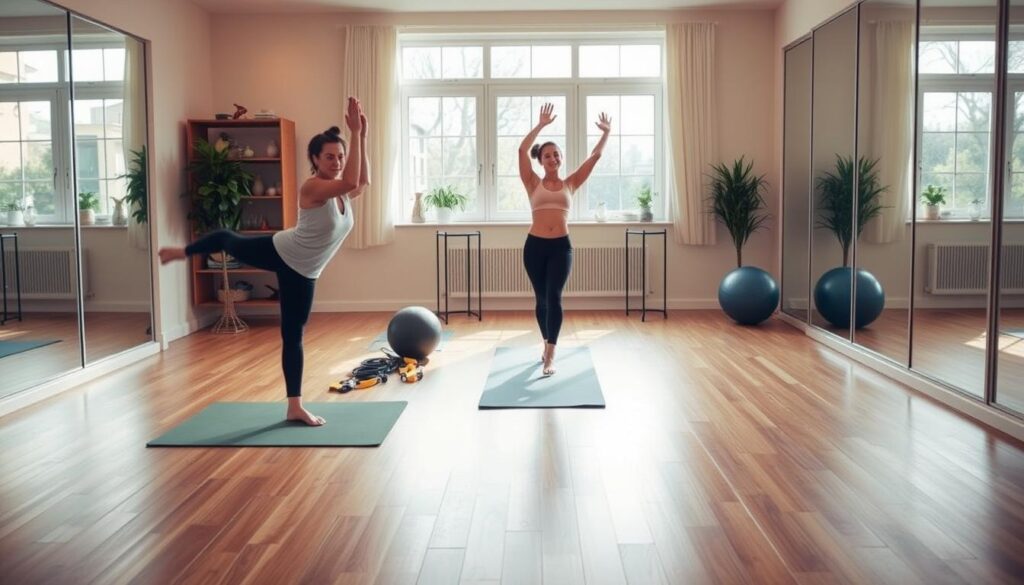
Beginner-Friendly Strength Training Exercises
Starting your fitness journey at home can be both exciting and intimidating. But with the right strength training exercises, you’ll be on your way to achieving your goals. Strength training is key for building muscle, increasing bone density, and boosting overall health.
For beginners, it’s essential to start with exercises that are both effective and easy to follow. The following sections will outline key strength training exercises targeting different muscle groups. This ensures a well-rounded fitness routine.
Upper Body Basics
Upper body strength is vital for everyday activities, from carrying groceries to playing with your kids. Here are some beginner-friendly exercises to get you started:
Modified Push-Ups and Dumbbell Exercises
Modified push-ups are a great way to build upper body strength without straining your joints. You can start with knee push-ups or incline push-ups. Dumbbell exercises like bicep curls and tricep extensions are also effective for targeting specific muscles.
Resistance Band Moves
Resistance bands are lightweight, inexpensive, and portable, making them perfect for home workouts. You can use them to perform exercises like banded chest presses and rows, which target your upper body muscles.
Lower Body Fundamentals
Lower body strength is equally important, supporting your overall mobility and balance. Here are some exercises to help you build a strong foundation:
Squat Variations for Beginners
Squats are a compound exercise that work multiple muscle groups. For beginners, it’s best to start with bodyweight squats or use a chair for support. As you gain confidence, you can progress to deeper squats or try variations like sumo squats.
Lunge and Bridge Exercises
Lunges are another effective exercise for building lower body strength. Start with walking lunges or stationary lunges, and focus on proper form. Bridge exercises target your glutes and can be done with or without weights.
Core Strengthening Moves
A strong core is the foundation of overall fitness, supporting your posture, balance, and athletic performance. Here are some beginner-friendly core exercises:
Planks, Russian twists, and leg raises are all effective exercises for building core strength. Start with shorter holds and gradually increase the duration as you build endurance.
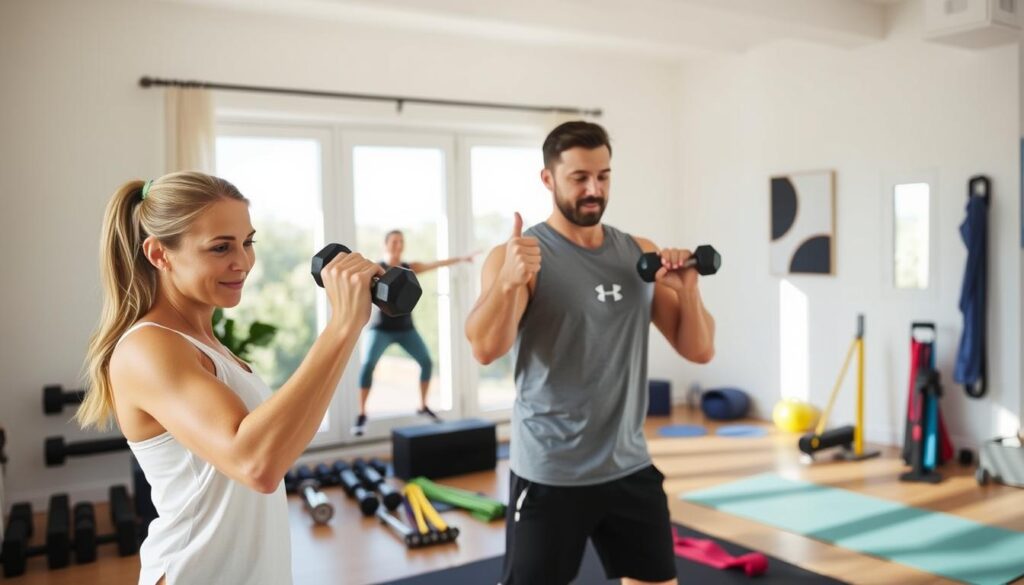
Simple Cardio Workouts You Can Do in Your Living Room
Getting fit at home is easier than ever. You can do simple cardio workouts in your living room. These exercises improve your heart health, boost your mood, and increase your energy. The best part is, you don’t need any special equipment to start.
Low-Impact Cardio Options
For beginners or those who prefer easier exercises, there are many options. Brisk walking in place is a simple and effective way to get your heart rate up. You can also try jogging in place or step-ups using a sturdy chair.
Beginner HIIT Routines
High-Intensity Interval Training (HIIT) is a great way to boost your cardio fitness. A beginner-friendly HIIT routine might include 30 seconds of jumping jacks followed by 30 seconds of rest, repeated for 15-20 minutes. You can also incorporate burpees, mountain climbers, or sprints in place.
Apartment-Friendly Cardio Without Jumping
For those living in apartments or with limited space, there are still plenty of cardio options. Try marching in place, seated leg lifts, or arm circles. These exercises can be just as effective at getting your heart rate up without the noise or impact.
| Exercise | Duration | Intensity |
|---|---|---|
| Brisk Walking in Place | 5 minutes | Low |
| HIIT Routine | 20 minutes | High |
| Marching in Place | 10 minutes | Medium |
Flexibility and Mobility Exercises for Beginners
Flexibility and mobility exercises are key for beginners. They help improve your range of motion and lower injury risk. Adding these to your home workout routine boosts your fitness and makes daily tasks easier.
10-Minute Post-Workout Stretching Routine
A post-workout stretching routine is vital for better flexibility and muscle recovery. Here are some essential stretches to include:
- Neck Stretch: Slowly tilt your head to the side, bringing your ear towards your shoulder.
- Shoulder Rolls: Roll your shoulders forward and backward in a circular motion.
- Chest Stretch: Stand in a doorway with your hands on the doorframe at shoulder height.
- Quad Stretch: Stand with one hand against a wall for balance and lift one leg behind you.
Yoga-Inspired Moves for Better Flexibility
Yoga-inspired moves can greatly enhance flexibility and balance. Some beginner-friendly poses include:
- Downward-Facing Dog: Starts on all fours, then lift your hips up and back.
- Warrior Pose: Stand with your feet wide apart, with one foot facing forward and the other foot at a 90-degree angle.
- Tree Pose: Stand on one leg, with the other foot resting on the inner thigh.
These exercises not only boost flexibility but also improve balance and overall fitness.
Complete 7-Day Beginner Home Workout Plan
Starting your fitness journey with a 7-day beginner home workout plan is a great idea. It includes strength training, cardio, and rest days. This mix keeps you motivated and on track.
Day-by-Day Workout Breakdown
Here’s a look at what your week could be like with a balanced routine.
Strength Days (Monday, Wednesday, Friday)
Strength days focus on exercises that work many muscles at once. Squats, lunges, push-ups, and rows are good for building strength. Do 2-3 sets of 8-12 reps for each exercise.
- Monday: Upper body strength training (push-ups, dumbbell rows)
- Wednesday: Lower body strength training (squats, lunges)
- Friday: Core strength training (planks, Russian twists)
Cardio Days (Tuesday, Thursday)
Cardio days boost heart health and burn calories. Choose low-impact cardio like brisk walking, jogging in place, or jumping jacks. Aim for 20-30 minutes per session.
- Tuesday: 20-minute brisk walking or jogging in place
- Thursday: HIIT (High-Intensity Interval Training) for 20 minutes
Active Recovery Days (Saturday, Sunday)
Active recovery days help your body heal and rebuild. Do light activities like yoga or a leisurely walk.
- Saturday: 10-minute yoga routine
- Sunday: Light stretching or a leisurely walk
Rest and Recovery Guidelines
Rest and recovery are key to any workout plan. Make sure to get 7-9 hours of sleep each night and take rest days as planned.
Tips for Better Recovery:
- Stay hydrated by drinking plenty of water
- Eat a balanced diet with proteins, complex carbs, and healthy fats
- Try relaxation techniques like meditation or deep breathing exercises
Common Mistakes Beginners Make When Working Out at Home
Starting your fitness journey at home can be exciting. But, it’s important to watch out for common mistakes. Working out at home is convenient, but without the right guidance, you might fall into bad habits.
Form and Technique Issues
One big mistake is ignoring proper form and technique. Without a trainer, it’s easy to do exercises wrong. This can cause injuries or make your workouts less effective. Learn the right way to do each exercise and use online resources or apps for help.
Overtraining Risks and Warning Signs
Another mistake is overtraining. It’s easy to get too excited and work out too much. This can lead to burnout, injury, or exhaustion. Watch for signs like constant tiredness, lower performance, or a higher resting heart rate. Make sure to include rest days in your routine.
Setting Unrealistic Expectations
Setting goals that are too high is another common mistake. It’s key to have realistic goals and celebrate small wins. Break down big goals into smaller steps and be patient. Fitness is a journey, not a quick fix.
| Mistake | Consequence | Solution |
|---|---|---|
| Poor Form and Technique | Injury or Ineffective Workout | Learn Correct Form, Use Online Resources |
| Overtraining | Burnout, Injury, or Exhaustion | Balance Workout Routine with Rest Days |
| Unrealistic Expectations | Disappointment or Frustration | Set Achievable Goals, Celebrate Small Victories |
How to Progress from Beginner to Intermediate Home Workouts
To move from beginner to intermediate home workouts, you need a plan. Start by making your workouts harder and more varied. This keeps you challenged and helps you grow.
When and How to Increase Exercise Intensity
Boosting exercise intensity is key to getting better. You can do this by adding more repetitions or sets, decreasing rest time between exercises, or introducing more challenging variations of your current exercises. For instance, if you’re doing bodyweight squats, try weighted squats or jump squats next.
Adding Variety to Prevent Plateaus
Mixing up your workout keeps it fun and targets different muscles. Try different types of exercises, like switching from regular push-ups to diamond push-ups. You can also introduce new equipment like resistance bands or dumbbells.
Signs You’re Ready for More Advanced Moves
Knowing when to move to harder moves is important. Look for signs like being able to do your current routine easily, feeling like you’re not being challenged anymore, or having reached your initial fitness goals. When you see these signs, it’s time to update your workout plan.
Tracking Progress and Staying Motivated with Home Workouts
Tracking your progress and staying motivated are key to a successful home workout routine. Without a gym, it’s easy to lose focus. But, with the right strategies, you can keep your enthusiasm high and reach your fitness goals.
Setting SMART Fitness Goals
Setting Specific, Measurable, Achievable, Relevant, and Time-bound (SMART) goals helps a lot. Clear objectives give you a target to aim for. For instance, “I will do 10 push-ups in a row in 6 weeks” is a SMART goal. This makes tracking progress easier and keeps you focused.
Using Apps and Technology to Track Workouts
Technology can greatly improve your home workout experience. There are many apps and tools to track your workouts and offer guidance. Apps like MyFitnessPal and Nike Training Club provide structure and motivation. They offer personalized plans, progress charts, and community support, which are very motivating.
Creating Accountability Systems
Having someone or something to report to can really motivate you. Find a workout buddy, even online, to share your journey. Joining online fitness communities or forums can also give you a sense of belonging. Sharing your goals and progress on social media can get you support and encouragement from friends and family.
By using these strategies, you can build a strong support system. This will keep you motivated and committed to your home workout routine.
Conclusion: Building a Sustainable Fitness Habit at Home
Starting a home workout routine is just the first step towards a healthier lifestyle. To achieve long-term success, it’s essential to build a sustainable fitness habit. By adding home exercises for beginners to your daily routine, you’ll be more likely to stick with it and see lasting results.
As you’ve learned, creating a workout space, setting realistic expectations, and tracking progress are crucial. By following the 7-day beginner home workout plan and gradually increasing exercise intensity, you’ll be well on your way to developing a consistent fitness routine.
Remember, the key to a sustainable fitness habit is to make it enjoyable and convenient. Experiment with different home exercises for beginners, and don’t be afraid to try new things. With time and dedication, exercising at home will become an integral part of your lifestyle. It will help you achieve your fitness goals and maintain overall well-being.

